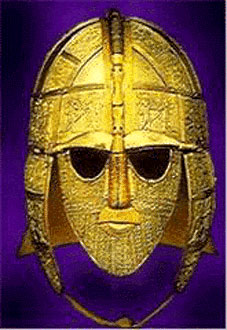
Event: Pagan belief: burial and beyond - Sutton Hoo 2006 Dated: 14/10/2006 - 14/10/2006
Category: Conference Location: Ipswich
Weblink:
www.suttonhoo.org/
Detail: THE SUTTON HOO SOCIETY CONFERENCE 2006
 Sutton Hoo gold buckle
Sutton Hoo gold buckle
PAGAN BELIEF: BURIAL AND BEYOND
Saturday 14 October
at
The Royal Hospital School, Holbrook, Ipswich
Tickets include lunch, tea and coffee:
SHS members: ?20.00
Non-members: ?25.00
Students: ?15.00
Please make it clear which category you are paying for and how many tickets you would like.
Make cheques payable to The Sutton Hoo Society and post to:
Mike Argent (Hon Treasurer) 2 Meadowside, Wickham Market,
Woodbridge, Suffolk IP13 0UD
PLEASE ENCLOSE AN A4 SAE
TICKETS AND CONFERENCE PACK WILL BE POSTED TO YOU IN SEPTEMBER
 Lid of a cloth purse
Lid of a cloth purse
CONFERENCE SPEAKERS
Chambers of Dreams: the Sutton Hoo burials and where they may take us:
Martin Carver is Professor of Archaeology at the University of York and editor of ANTIQUITY, the international journal of world archaeology.
Starting with the idea of David Lewis-Williams- thesis The Mind in the Cave, the proposition that all humans dream, and that interpreters of dreams have been active as religious leaders since the paleolithic, Professor Carver will examine the loosely termed -shamans- and their role among the Vikings, vividly described by Neil Price in his book The Viking Way. Did the pagan Anglo-Saxons have spiritual specialists too? What was their job? Were they the designers of the Sutton Hoo burials? Is it true they were mainly women? What happened to them when England became Christian? And how did they relate to the self-styled kings of early England.
 Casket (box) - Scandinavia ca. 1000 mammoth ivory and bronze
Casket (box) - Scandinavia ca. 1000 mammoth ivory and bronze
A Well Urned Rest: Cremation practices and cremation cemeteries in Anglo-Saxon England:
Dr. Howard Williams lectures in Archaeology at the University of Exeter.
He will reconsider the practice of cremating the dead and burying the ashes in urns within communal burial grounds as evidence of pre-Christian belief and practice in early Anglo-Saxon East Anglia.
The paper looks at three issues: (a) the landscape situation of cremation cemeteries:
(b) the spatial organisation of cemeteries: and (c) the artefacts placed with the dead
He will consider how burning the dead and burying the ashes might be influenced by pragmatic, economic, social, political and ideological factors, as well as by strategies of commemoration.
Men and Monsters: artefacts, iconography and ideology in sixth-century England:
Dr.Tania Dickinson lectures in Archaeology at the University of York.
Taking her cue from the discovery of grave 868 in the northern cemetery at Sutton Hoo, Dr. Dickinson will discuss the nature, context and meaning of the most abundant of all animal-art styles used in Anglo-Saxon England - Salin-s Style I. Her argument will progress from a review of the incidence of Style I in the burial record, the types of object on which it occurs and particularly their gender-associations, to focus on the objects and their motifs in male/masculine contexts. Study of these suggests that belief systems and social behaviours had already appeared in England a century or more earlier than Salin-s Style II, more usually associated with the barrow cemetery at Sutton Hoo.
The Beast Within? Breaching human-animal boundaries in Anglo-Saxon paganism and the impact of the conversion to Christianity:
Dr. Aleksander Pluskowski lectures in Archaeology at the University of Cambridge.
Dr. Pluskowski will explain that certain species, notably dogs, horses and a range of wild animals, were employed in the construction and visual expression of human identity within pagan Anglo-Saxon society. Here, the active use of animals in social, political and cosmological organisation breached the boundaries between species; a -zoocentric- worldview that was also found in other parts of northern Europe, particularly Scandinavia. In England, the acceptance of Christianity resulted in the abandonment of a -zoocentric- in favour of an -anthropocentric- world-view, and the boundary separating humans from other animals began to harden. The same process occurred in southern Scandinavia several centuries later, providing us with a glimpse of the conceptual paths that may have been taken in Anglo-Saxon England.
Mythic Landscapes: cult and topography in the mind of the Anglo-Saxon:
Dr. Sarah Semple lectures in Archaeology at the University of Chester.
Early medieval communities inhabited a landscape layered in memory and meaning. The place-name record offers a unique insight into these beliefs and thoughts regarding landscape, showing that communities imbued the natural and man-made world with supernatural properties and associations. Amid these names are places of cult significance - locations in the landscape where -pagan practices- may have taken place. This paper, based upon recent archaeological investigations at several of these locations, seeks to explore what these sites comprised and how they may have functioned in the early medieval period.
The Sutton Hoo Society, by positively encouraging and promoting new ideas and discussion, is rapidly becoming known as holding one of the finest conferences on the circuit.

